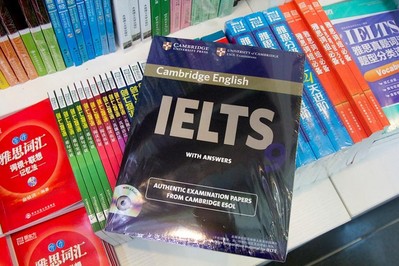 返回
教育头条
返回
教育头条

雅思写作高分思路分享
雅思写作的高分思路是什么样子的? 小编这里分享一个雅思写作高分思路: 对题目关键词进行同义转换,和核心观点的关键词在举例中一一具体化 。
如下: It is important for childrento learn the difference between right and wrongat an early age. Punishmentis necessary to help them learn this distinction. To what extent do you agree or disagree with this opinion? What sort of punishment should parents and teachers be allowed to use to teach good behaviour to children?
我们看到考官范文的后一自然段,针对第二个问题的回答,也就是讨论哪些惩罚方法可以使用。 Rather, teachers and parents can use a variety of methods to disciplinetheir young charges, such as detention, withdrawal of privileges, and time-out. Making the punishment fit the crime is a useful notion, which would see children being made to pick up rubbish they have dropped, clean up graffiti they have drawn, or apologize to someone they have hurt. In these ways responsibility is developed in the child, which leads to much better future behavior than does punishment.
一、句话,核心是说明其实有很多方法可以用来惩罚孩子。 题目中的名词punishment变成了discipline sb.动词短语表示处罚某人,题目中的children变成了young charges 表示年轻的受照料者们,也就是小孩的意思,通过使用近义词对题中的两处关键词进行同义转换,体现了词汇的多样性。 光说有很多方法很空洞,于是在句末列举了三个小例子,detention, withdrawal ofprivileges, withdrawal oftime-out(意思分别是留堂、取消特权、取消休息时间),使用了下义词对punishment进行同义转换和进一步细化。

第二句话,考官提出了一个核心观点 ,应该让惩罚与罪行相适应making the punishmentfit the crime。 接下来就是对核心观点进行举例论证 ,这个拓展方式很多同学都会用,但是经常会出现的情况是举的例子和核心观点不是一一对应,或是举例中有很多多余的细节,反而跟核心观点对应的部分只提了几个词。然而在高分写法中,举例应该是对核心观点进行具体化,比如核心观点中的crime和punishment,对应到例子中是drop the rubbish和pick up rubbish,draw graffiti和clean up graffiti,hurt someone和apologize to someone。共三个例子,每个例子中都能体现核心观点的关键词,整体意思上也和观点句吻合。 这样的写法可以避免举例无证观点的情况,而且对观点进行了直接的拓展具体化,高分无疑。
如下: It is important for childrento learn the difference between right and wrongat an early age. Punishmentis necessary to help them learn this distinction. To what extent do you agree or disagree with this opinion? What sort of punishment should parents and teachers be allowed to use to teach good behaviour to children?
我们看到考官范文的后一自然段,针对第二个问题的回答,也就是讨论哪些惩罚方法可以使用。 Rather, teachers and parents can use a variety of methods to disciplinetheir young charges, such as detention, withdrawal of privileges, and time-out. Making the punishment fit the crime is a useful notion, which would see children being made to pick up rubbish they have dropped, clean up graffiti they have drawn, or apologize to someone they have hurt. In these ways responsibility is developed in the child, which leads to much better future behavior than does punishment.
一、句话,核心是说明其实有很多方法可以用来惩罚孩子。 题目中的名词punishment变成了discipline sb.动词短语表示处罚某人,题目中的children变成了young charges 表示年轻的受照料者们,也就是小孩的意思,通过使用近义词对题中的两处关键词进行同义转换,体现了词汇的多样性。 光说有很多方法很空洞,于是在句末列举了三个小例子,detention, withdrawal ofprivileges, withdrawal oftime-out(意思分别是留堂、取消特权、取消休息时间),使用了下义词对punishment进行同义转换和进一步细化。

第二句话,考官提出了一个核心观点 ,应该让惩罚与罪行相适应making the punishmentfit the crime。 接下来就是对核心观点进行举例论证 ,这个拓展方式很多同学都会用,但是经常会出现的情况是举的例子和核心观点不是一一对应,或是举例中有很多多余的细节,反而跟核心观点对应的部分只提了几个词。然而在高分写法中,举例应该是对核心观点进行具体化,比如核心观点中的crime和punishment,对应到例子中是drop the rubbish和pick up rubbish,draw graffiti和clean up graffiti,hurt someone和apologize to someone。共三个例子,每个例子中都能体现核心观点的关键词,整体意思上也和观点句吻合。 这样的写法可以避免举例无证观点的情况,而且对观点进行了直接的拓展具体化,高分无疑。
以上内容为教育宝【王敏】编辑整理的内容,我已开通官方个人微信号(18560125702)。选雅思课程,不焦虑!就让我来帮助你,就像帮助我自己,如果需要获得帮助,建议您加加我微信,可以十分便捷的和我充分互动交流,我会为您提供答疑指导等一条龙学习服务!返回教育宝头条
【免责声明】本文仅代表作者本人观点,与教育宝无关。教育宝对文中陈述、观点判断保持中立,不对所包含内容的准确性、可靠性或完整性提供任何保证。请读者仅作参考,特此声明!





